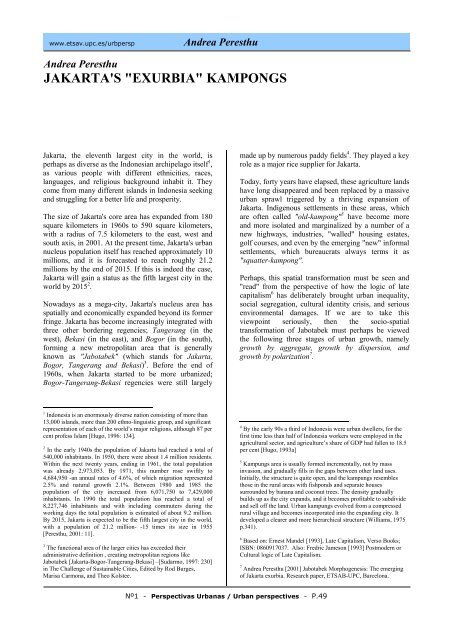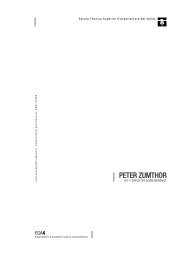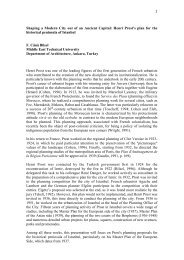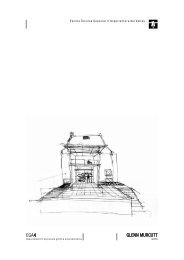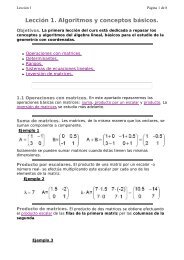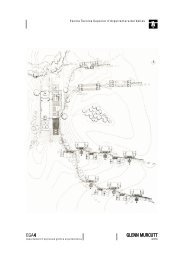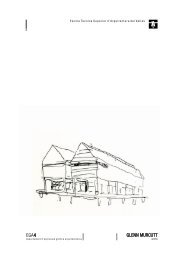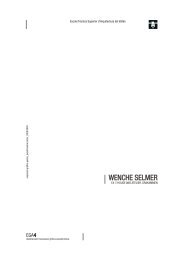You also want an ePaper? Increase the reach of your titles
YUMPU automatically turns print PDFs into web optimized ePapers that Google loves.
www.etsav.upc.es/urbpersp Andrea Peresthu<br />
Andrea Peresthu<br />
<strong>JAKARTA'S</strong> "EXURBIA" <strong>KAMPONGS</strong><br />
Jakarta, the eleventh largest city in the world, is<br />
perhaps as diverse as the Indonesian archipelago itself 1 ,<br />
as various people with different ethnicities, races,<br />
languages, and religious background inhabit it. They<br />
come from many different islands in Indonesia seeking<br />
and struggling for a better life and prosperity.<br />
The size of Jakarta's core area has expanded from 180<br />
square kilometers in 1960s to 590 square kilometers,<br />
with a radius of 7.5 kilometers to the east, west and<br />
south axis, in 2001. At the present time, Jakarta's urban<br />
nucleus population itself has reached approximately 10<br />
millions, and it is forecasted to reach roughly 21.2<br />
millions by the end of 2015. If this is indeed the case,<br />
Jakarta will gain a status as the fifth largest city in the<br />
world by 2015 2 .<br />
Nowadays as a mega-city, Jakarta's nucleus area has<br />
spatially and economically expanded beyond its former<br />
fringe. Jakarta has become increasingly integrated with<br />
three other bordering regencies; Tangerang (in the<br />
west), Bekasi (in the east), and Bogor (in the south),<br />
forming a new metropolitan area that is generally<br />
known as "Jabotabek" (which stands for Jakarta,<br />
Bogor, Tangerang and Bekasi) 3 . Before the end of<br />
1960s, when Jakarta started to be more urbanized;<br />
Bogor-Tangerang-Bekasi regencies were still largely<br />
1 Indonesia is an enormously diverse nation consisting of more than<br />
13,000 islands, more than 200 ethno-linguistic group, and significant<br />
representation of each of the world’s major religions, although 87 per<br />
cent profess Islam [Hugo, 1996: 134].<br />
2 In the early 1940s the population of Jakarta had reached a total of<br />
540,000 inhabitants. In 1950, there were about 1.4 million residents.<br />
Within the next twenty years, ending in 1961, the total population<br />
was already 2,973,053. By 1971, this number rose swiftly to<br />
4,684,950 -an annual rates of 4.6%, of which migration represented<br />
2.5% and natural growth 2.1%. Between 1980 and 1985 the<br />
population of the city increased from 6,071,750 to 7,429,000<br />
inhabitants. In 1990 the total population has reached a total of<br />
8,227,746 inhabitants and with including commuters during the<br />
working days the total population is estimated of about 9.2 million.<br />
By 2015, Jakarta is expected to be the fifth largest city in the world,<br />
with a population of 21.2 million- -15 times its size in 1955<br />
[Peresthu, 2001: 11].<br />
3 The functional area of the larger cities has exceeded their<br />
administrative definition , creating metropolitan regions like<br />
Jabotabek [Jakarta-Bogor-Tangerang-Bekasi] –[Sudarmo, 1997: 230]<br />
in The Challenge of Sustainable Cities, Edited by Rod Burges,<br />
Marisa Carmona, and Theo Kolstee.<br />
made up by numerous paddy fields 4 . They played a key<br />
role as a major rice supplier for Jakarta.<br />
Today, forty years have elapsed, these agriculture lands<br />
have long disappeared and been replaced by a massive<br />
urban sprawl triggered by a thriving expansion of<br />
Jakarta. Indigenous settlements in these areas, which<br />
are often called "old-kampong" 5 have become more<br />
and more isolated and marginalized by a number of a<br />
new highways, industries, "walled" housing estates,<br />
golf courses, and even by the emerging "new" informal<br />
settlements, which bureaucrats always terms it as<br />
"squatter-kampong".<br />
Perhaps, this spatial transformation must be seen and<br />
"read" from the perspective of how the logic of late<br />
capitalism 6 has deliberately brought urban inequality,<br />
social segregation, cultural identity crisis, and serious<br />
environmental damages. If we are to take this<br />
viewpoint seriously, then the socio-spatial<br />
transformation of Jabotabek must perhaps be viewed<br />
the following three stages of urban growth, namely<br />
growth by aggregate, growth by dispersion, and<br />
growth by polarization 7 .<br />
4 By the early 90s a third of Indonesia were urban dwellers, for the<br />
first time less than half of Indonesia workers were employed in the<br />
agricultural sector, and agriculture’s share of GDP had fallen to 18.5<br />
per cent [Hugo, 1993a]<br />
5 Kampungs area is usually formed incrementally, not by mass<br />
invasion, and gradually fills in the gaps between other land uses.<br />
Initially, the structure is quite open, and the kampungs resembles<br />
those in the rural areas with fishponds and separate houses<br />
surrounded by banana and coconut trees. The density gradually<br />
builds up as the city expands, and it becomes profitable to subdivide<br />
and sell off the land. Urban kampungs evolved from a compressed<br />
rural village and becomes incorporated into the expanding city. It<br />
developed a clearer and more hierarchical structure (Williams, 1975<br />
p.341).<br />
6 Based on: Ernest Mandel [1993], Late Capitalism, Verso Books;<br />
ISBN: 0860917037. Also: Fredric Jameson [1993] Postmodern or<br />
Cultural logic of Late Capitalism.<br />
7 Andrea Peresthu [2001] Jabotabek Morphogenesis: The emerging<br />
of Jakarta exurbia. Research paper, ETSAB-UPC, Barcelona.<br />
Nº1 - Perspectivas Urbanas / Urban perspectives - P.49
www.etsav.upc.es/urbpersp Jakarta’s "exurbia" kampongs<br />
Growth by Aggregate during 1970s<br />
Immediately after the slow down of the worldeconomy<br />
in the 70s and the energy-crisis penetrated<br />
most industrial countries in Europe, North America,<br />
and Japan, capitalists downsized their business and<br />
decentralized their center of production across the<br />
world 1 . At that time, South East Asian countries<br />
became more eligible and attractive for the foreign<br />
investors to make them as their business base.<br />
Indonesia was no exception. Jakarta and its<br />
surrounding regions suddenly became one of the most<br />
attractive places to invest in the Pacific Rim. Soeharto's<br />
1 David Harvey named it as “sea change” and it caused space-time<br />
compression [1989]. See also: Contemporary Spatial Strategies and<br />
Urban Policies in Developing Countries: A Critical Review [Burges,<br />
Carmona, Kolstee, 1997: 111-124]<br />
Nº1 - Perspectivas Urbanas / Urban perspectives - P.50<br />
regime at that time was also very committed to<br />
encourage such trend. They stated the following<br />
political wills. Firstly, they would like to make<br />
Indonesia as one of the most important players in<br />
OPEC (to guarantee sustainable domestic energy and<br />
raw material supplies for foreign investments).<br />
Secondly, they would like to take advantage of the<br />
status as having the lowest labor cost among the South<br />
East Asian countries. Thirdly, they considered that<br />
discussions on the critical issues on labor rights,<br />
pollutions and environmental damages caused by<br />
industrialization must not be disclosed in public<br />
discourses. Certainly this is appealing to those foreign<br />
investors who wanted to seek an easy access without<br />
being constrained by political pressure groups.<br />
Fourthly, they would also guarantee a stable national<br />
security and ASEAN regional peace.<br />
Not surprisingly, after these political will were indeed<br />
implemented by the Soeharto's regime, a huge number
www.etsav.upc.es/urbpersp Andrea Peresthu<br />
of foreign investors entered the country in that period 2 .<br />
The economic growth increased significantly to around<br />
8.1 percent per annum during 70s and 80s 3 . Jabotabek's<br />
GDP per capita (1974-1981) was twice higher than the<br />
national GDP per capita, and it was even three times<br />
higher by the mid of 90s. As a result, Jabotabek<br />
became a major center of income generation and<br />
obviously it attracted many people from many different<br />
provinces in Indonesia to migrate. This has inevitably<br />
stimulated a massive labor force migration. They came<br />
to the region and struggled to find a job and to look for<br />
a better life.<br />
Rapidly, the silent "gemenschaft" terrain of BOTABEK<br />
was replaced by a new "gesselschaft" industry<br />
agglomeration . Land price and speculation increased<br />
drastically -especially along the arterial roads and<br />
along the riverbanks motivated by the desire to have an<br />
"easy" access for industry disposal outlets. At the same<br />
time, small-scale housing estates also started to<br />
develop cheap labor housing projects and many<br />
indigenous "old-kampong" settlements became a swift<br />
rent-housing provider.<br />
In brief, the growth by aggregate, which is stimulated<br />
by the shift in the global-economy, implies a sporadic<br />
spatial transformation in the form of urban sprawl<br />
emergence, conurbation symptom, and socio-spatial<br />
transformation of indigenous "old-kampong"<br />
settlements.<br />
Growth by Dispersion by the end of 1980s<br />
The growth by dispersion was triggered by three main<br />
factors:<br />
[1] the progress of GATT and AFTA (Asia Pacific<br />
Free Trade Alliance), in which Indonesia is a member.<br />
2 During the period 1974-1978 foreign investments reached US $<br />
338.1 million, with 37 projects, and it tripled to US $ 963 millions –<br />
with 38 projects, during 1979-1983. By the last period of 80s, only<br />
within two years (1989-1990) foreign investments reached US $<br />
1,381.5 millions with 181 projects. Most of the foreign investment<br />
originated from Japan was 39.8 per cent, Hong Kong it was 12.8 per<br />
cent, Europe was 20 per cent, American countries around 8.5 per<br />
cent, Australia and New Zealand were 2.4 per cent, Africa was 0.6<br />
per cent, and the others were 5.6 per cent [Peresthu; 2001: 25]<br />
3 During 70s GDP grew by 6.3 per cent in real terms [Word Bank,<br />
1984; NUDSP, 1985], later GDP growth slowed to 4.3 per cent per<br />
annum between 1981-1988 [Booth, 1992: 1]<br />
As a member, Indonesia is obliged to deregulate many<br />
economic aspects including financial, trade and<br />
industrial policies. Particularly, after the financial<br />
deregulation in 1985, the property-loan became easier<br />
to access. It was because many private banks crowded<br />
the market, thus creating a problem of oversupply of<br />
loan able funds. These banks offered property loan<br />
with a very competitive interest rate. As a result,<br />
massive real estate projects sprouted across the<br />
Jabotabek region.<br />
[2] The second factor is the automotive-industry<br />
deregulation whereby the government started to<br />
gradually reduce import tax levied on car. As a result,<br />
the price of car decreased tremendously. At the same<br />
time, banks also offered enormous "easy" consumer<br />
loans for car purchasing. This situation has had a great<br />
impact on the increasing of commuting trends in<br />
Jabotabek. This was because many people took<br />
advantage of these "easy" consumer loans and started<br />
to buy new houses beyond the inner Jakarta area. They<br />
thought that with the easy access to purchasing and<br />
owning a car, they would not have to worry anymore<br />
about having to live outside the inner Jakarta area and<br />
to rely on the "poor" public transport system.<br />
[3] The last factor was the new legislation that allowed<br />
the private sector to develop and to operate new<br />
highways 4 . These highways were very much controlled<br />
by the Soeharto's cronies and their foreign-investors<br />
counterparts. Consequently, many new highways were<br />
constructed all over the outskirt of Jakarta . They were<br />
well connected to each other and also reached some<br />
remote terrains, which people had barely visited<br />
before.<br />
These three factors that rooted in the spirit of latecapitalism<br />
were considered as the main trigger that<br />
accelerated the urban growth. The urban area became<br />
more dispersed, thus the notion of "growth by<br />
dispersion" seems to be justifiable.<br />
4 The construction and operation of highways was permitted and<br />
regulated by Act. No. 13 [1980] and Government Regulation No.8<br />
[1990].<br />
Nº1 - Perspectivas Urbanas / Urban perspectives - P.51
www.etsav.upc.es/urbpersp Jakarta’s "exurbia" kampongs<br />
The massive sprouting of new estates projects required<br />
a tremendous supply of lands located particularly in the<br />
outskirt of Jakarta. This drove up the land price and<br />
created land speculative practices 1 . Even worst, it<br />
caused a huge number of land-disputes 2 , which were<br />
solved in a very 'wicked' way. Sadly, the "oldkampong"<br />
settlements and farm landowners were<br />
disadvantaged. Many of them were under-pressure to<br />
sell their lands very cheaply. No price negotiation was<br />
possible. If they refused, they would then be labeled as<br />
communists 3 . Some of them are even still struggling<br />
1 See more: Many Developers Illegally Build Houses in Jakarta”.<br />
Jakarta Post [8 August 1990]; “Officials Believed Involved in<br />
Authorized Projects”. Jakarta Post [7 March 1989]; “Government to<br />
Revoke Permits of Delinquent Developers” . Jakarta Post [25 march<br />
1991].<br />
2 See more: “Developers, residents asked to discuss land dispute”<br />
Jakarta Post [25 April 1989]; “Land Disputes Dominate Complaints<br />
to Council” Jakarta Post [5 September 1988].<br />
3 See more: “Residents seeking protection against intimidation,<br />
Jakarta Post [19 March 1991]<br />
Nº1 - Perspectivas Urbanas / Urban perspectives - P.52<br />
until today because of such a crude action. Nowadays,<br />
many of these old settlements and farmlands have been<br />
transformed into new "walled and gated" estates that<br />
belong to Jakarta commuters.<br />
Also, the massive new estate projects were followed by<br />
enormous migration flows of construction labors from<br />
many areas in Indonesia. These migrant labors<br />
triggered many informal settlements nearby all of these<br />
construction projects. These migrants occupied the "no<br />
man's land", which was often a land under a legal<br />
dispute. At the beginning, these popular settlements<br />
seemed to be temporal, but then they evolved into more<br />
established and integrated economically or spatially<br />
with their surroundings. Recently, these informal<br />
settlements that are brought about by growth by<br />
dispersion are frequently labeled as "squatterkampongs".<br />
They constitute another form of sociospatial<br />
crisis again.
www.etsav.upc.es/urbpersp Andrea Peresthu<br />
Growth by Polarization<br />
The growth by polarization that commenced in the mid<br />
of 90s can be seen and analyzed using these following<br />
frameworks.<br />
[1] The Insular growth: the urban sprawl was<br />
continuing, but in a different scale and scope. It<br />
becomes more complex overtime, for instance many<br />
empty or unproductive farmlands, which were never<br />
considered as valuable and strategic, suddenly were<br />
transformed into hospitals, warehouses, universities,<br />
and golf courses 4 .<br />
[2] The ex-novo growth: Obviously, those new<br />
functions and projects were established or clustered<br />
along the highway corridors to guarantee accessibility 5 .<br />
Some of them demanded and insisted to have a direct<br />
exclusive access from the highways. This created an<br />
unbalanced and crowded road-connection system<br />
between the highways and the secondary roads, which<br />
then caused many physical damages to the roads and<br />
very serious traffic jams.<br />
[3] The Integrated linkage network: Immediately after<br />
Jabotabek linkage structure was completed and well<br />
connected with the airport, port, and highways, Jakarta<br />
was no longer considered as the center of the regional<br />
nexus anymore.<br />
[4] The reticular polarization: The urban growth has<br />
also shown other symptoms of massive amenities and<br />
facilities agglomerations in some new emerging cities<br />
within Jabotabek 6 . This trend is visible in the new city<br />
4 In 1994, government revised master plan as well as regional plan,<br />
which is known as Jabotabek Metropolitan Development Plan<br />
Review – JMDPR. This revised plan includes 18 largest scale,<br />
residential, amenities, and new town projects proposed by private<br />
developers [JICA, 1994].<br />
5 The accumulation of highway length increased from 46 kilometers<br />
by 1978 [which connected Jakarta – Bogor] to 285.9 kilometers by<br />
the end of 1996, and recently it has around 390 kilometers total<br />
highways length in Jabotabek area [Peresthu, 2001: 37]<br />
6 The prominent new towns built or planned by private real estate<br />
developers in BOTABEK Region are among others: In the regency<br />
of Tangerang, West of Jakarta : the Bumi Serpong Damai (BSD)<br />
New Town of about 6,000 hectares; Tigaraksa New Town of about<br />
3,100 hectares and Lippo Village, Karawaci of about 2,600 hectares;<br />
Pantai Jndah Kapuk of about 800 hectares; Alam Sutera of about 700<br />
hectares; Kapuk Naga, 8,000 hectaers; Binatro Jaya of about 2,300<br />
of Lippo Karawaci that is located roughly 35<br />
kilometers to the west of Jakarta. This new city is<br />
perhaps the most "prestigious" city that Indonesia has<br />
ever had. It is the headquarter location of the powerful<br />
business group, Lippo. It consists of a five star hotel,<br />
university, international standard hospital, cultural<br />
center, small-scale airport, shopping mall, and indeed a<br />
golf course 7 .<br />
This recent urban growth indeed has a direct impact on<br />
the socio-spatial transformation of Jakarta. Inevitably,<br />
environmental damages cannot be avoided.<br />
Tremendous social crisis also exploded across<br />
Jabotabek. For instance, the more eager are the<br />
capitalists to acquire lands to cater their businesses or<br />
just to engage in speculative deals, the more frequent<br />
hectares; Citra Raya New Town, 2,000 Hectares; Modern Land of<br />
770 hectares; Citra Grand City of about 1,000 hectares; Villa<br />
Permata of about 700 hectares and Palm Spring Village of about 100<br />
hectares; Pun Jaya City, about 2,000 hectares, and others are in the<br />
pipeline such as the Citraland New Town and the Serpong Gading<br />
New Town. In the regency of Bekasi, East of Jakarta: the Bekasi<br />
Integrated New Town of about 1,300 hectares, Cikarang Baru New<br />
Town of about 5,400 hectares; Bekasi 2000 New Town of about<br />
2,000 hectares, Lippo Cikarang of about 5000 hectares, Legend New<br />
City of about 2,000 hectares and Bekasi New City which is planned<br />
to develop an area of about 3,000 hectares, Bumi Bekasi Baru New<br />
Town, 1,500 Hectares. Others are in the regency of Bogor, South of<br />
Jakarta: Jonggol Asri about 33,000 hectares; Citra Indah City, about<br />
1,200 hectares; Royal Sentul New City of about 2,000 hectares; Lido<br />
Lake Resort City of about 1,700 hectares; Rancamaya New City of<br />
about 550 hectares and the Cariu New Town of about 6,000 hectares.<br />
Within the city of Jakarta itself, several new towns in town had also<br />
been developed by private developers such as The Kemayoran New<br />
Town in the northern central part of Jakarta; Pantai Indah Kapuk<br />
New Town and Pluit New Town in the Northern Coastal Area of<br />
Jakarta and Pondok Jndah in the South Western part of the city of<br />
Jakarta and in the planning of Marunda New Community [Peresthu,<br />
2001: 39-40]<br />
7 Private land developers provide new world for (upper) middle and<br />
upper class people, who live in gated communities. The new towns<br />
Lippo Karawaci and Bumi Serpong Damai, both in Tangerang, even<br />
try to be self-sufficient towns [kota mandiri], with a state-of-the-art<br />
infrastructure. Many elements of such a modern world have a higher<br />
symbolic meaning than practical use. Most resident, i.e., cannot<br />
afford to use the golf course, however, the are proud to have one<br />
[Leisch, 2000: 4-12]<br />
Nº1 - Perspectivas Urbanas / Urban perspectives - P.53
www.etsav.upc.es/urbpersp Jakarta’s "exurbia" kampongs<br />
land disputes occurred 1 . This kind of land acquisition,<br />
in general, happens to the ordinary people, which are<br />
often uneducated farmers. They are likely to be<br />
intimidated to sell their land cheaply.<br />
In the meantime, planning policies remained steady or<br />
even stagnant. Government is no longer controlled and<br />
audited spatial development anymore, because the<br />
logic of capitalism has long become their patron.<br />
Government perhaps preferred to support and legalize<br />
private schemes rather than to seriously question the<br />
sustainability of the development.<br />
Conclusion and Further Research<br />
1 see more: Bernard Dorleans, The Land Speculation and The City<br />
Planning Problems in Jakarta. Workshop paper in The Indonesia<br />
Town Revisited, Leiden University, 6-8 December 2000.<br />
Nº1 - Perspectivas Urbanas / Urban perspectives - P.54<br />
In brief, those stages of urban growth perhaps imply<br />
how the geography and the logic of late capitalism<br />
intersect in a complex socio-spatial process, which<br />
inevitably creates a serious urban inequalities, social<br />
segregation, cultural identity crisis, and environmental<br />
damages 2 . This notion of complex socio-spatial process<br />
can perhaps be pondered from the following two<br />
aspects. The First aspect is the way the indigenous<br />
"old kampong" settlements have been transformed and<br />
assorted in the wake of the continuing urban growth.<br />
The Second aspect is the way the emerging new<br />
informal squatter settlements (squatter-kampong) are<br />
spatially, economically, and culturally formed. Also,<br />
the way they struggle and become more integrated with<br />
its surroundings.<br />
2 Those negative impact, theoretically have been mentioned by Ed.<br />
Soja as “a constantly evolving historical sequence of spatialties”<br />
[Soja 1989; 75].
www.etsav.upc.es/urbpersp Andrea Peresthu<br />
In term of urban inequality, both old-kampong and<br />
squatter-kampong face the same fate. They are<br />
deliberately marginalized by the rapid encroachment of<br />
the spatial growth and the capitalism spirit. Throughout<br />
the aforementioned three stages of urban growth, old<br />
kampong is perhaps hardly considered in the blueprint<br />
of the regional economic and spatial planning.<br />
The same fate is shared by the informal migrant<br />
settlements. Kampong's inhabitants are spatially and<br />
economically marginalized, and yet they survived. The<br />
reason for their survival is almost like a shrouded<br />
mystery. We never really understand it. Nevertheless,<br />
we can observe some cases indicating this survival<br />
ability. The first one is the case of indigenous "oldkampong"<br />
settlements that take up the opportunity to<br />
provide rental housing to migrant labors. The second<br />
one is the case of migrant labors that occupy "no-man"<br />
lands surrounding estate projects in order to afford a<br />
cheap settlement. These new settlements have recently<br />
evolved into "squatter kampongs". Theoretically, these<br />
cases perhaps can be viewed as being examples<br />
demonstrating the effort of the kampongs people to<br />
adopt the logic of "geography-capitalism intersection<br />
in a complex socio-spatial process", albeit of in a<br />
different platform.<br />
The mushrooming of satellite cities, new estates,<br />
amenities, and warehouses were immediately followed<br />
by the social segregation problem. This is because<br />
concrete wall and gates often always surround these<br />
new communities. There is no direct link between<br />
indigenous neighborhoods and these new communities.<br />
When people from kampongs work inside the new<br />
estate as a maid or gardener, they always have to pass<br />
the control gate everyday. There are hardly attempts to<br />
start a social contact between these new communities<br />
and their surrounding neighborhoods.<br />
The people who live inside these "walled communities"<br />
live in a 'bourgeois' environment. First quality water<br />
and electricity supplies, nice and fancy streets, gardens,<br />
sport facilities, supermarkets, schools, and twenty-four<br />
hours security guards are provided to them. Ironically,<br />
not more than a kilometers radius from their wall, there<br />
are indigenous neighbors who lack clean water and<br />
electricity. Their houses are often not in a good state to<br />
live in because of lacking good sanitation facilities.<br />
This social contrast, which represents a spatial<br />
disruption and imbalance in prosperity, can perhaps be<br />
considered as one of the triggers causing some looting<br />
actions to the new estates, shopping centers, and malls<br />
during the "Black May" riot in 1998 3 . The fundamental<br />
question in this context is who isolates and being<br />
spatially isolated.<br />
As we mentioned before, the urban growth engenders<br />
serious environmental damages such as water or air<br />
pollution, floods, and traffic jam. They are not only<br />
caused by the emerging of new housing estates or the<br />
gigantic reticular polarization, but also by the spatial<br />
transformation of "old-kampongs", as well as the<br />
emergence of "squatter-kampong". The latter causes<br />
are hardly mentioned, discussed, or even included in<br />
the formal spatial planning policy scheme. The<br />
government only categorized them as an informal<br />
sector. Thus, nowadays Jabotabek does not posses any<br />
strategic spatial policy, which integrates and takes into<br />
account these "exurbia" 4 kampongs phenomena.<br />
In this research, I would like to further elaborate these<br />
kind of informal settlements and their neighborhood<br />
from a socio-spatial transformation viewpoint. The<br />
research has the following goals.<br />
Nº1 - Perspectivas Urbanas / Urban perspectives - P.55<br />
1. To elaborate, in a more comprehensive and<br />
deeper way, these three stages of urban<br />
growth evolution, i.e. growth by aggregate,<br />
growth by dispersion, and growth by<br />
polarization.<br />
2. To link the socio-spatial transformation with<br />
the urban growth using a scheme that<br />
integrates economic, social, cultural, and<br />
spatial analysis on both "old-kampong" and<br />
the emerging "squatter-kampong".<br />
3. To provide a critical review on Jabotabek's<br />
spatial policies, planning instruments, linkage<br />
3 The environmental sustainability of many Third World Cities,<br />
particularly in relation to energy, food, and water supplies, is under<br />
question [Burges, Carmona, Kolstee, 1997: 70].<br />
4 The term of “exurbia” is adapted from: Alvin Rosenbaum and<br />
Marcy Mermel [1995]. Why now is the Time to Rethinking<br />
Regionalism. Cornell Journal of Planning and Urban Issues, spring<br />
1995, Vol. X, pp. 31-37. Also with the work of Albert Pope [1996].<br />
Ladders. Rice University School of Architecture.
www.etsav.upc.es/urbpersp Jakarta’s "exurbia" kampongs<br />
structures, demographic trends, regulations,<br />
and regional economic analysis.<br />
4. To offer a critical review on the institutional<br />
aspects of Jabotabek's spatial planning and<br />
urbanism.<br />
5. To present a critical review on the sociospatial<br />
approach that takes into account the<br />
connectedness and separateness of several<br />
specific spots in the region of Jabotabek. It is<br />
expected that this critical review can reveal<br />
the complexity and contradiction of spatial<br />
nexus embedded in the interplay among the<br />
"old-kampong", "reticular growth", and<br />
"squatter kampong".<br />
These five research goals are, of course, going to be<br />
continuously developed and improved. The next<br />
immediate step that I would like to do is to build some<br />
sounds theoretical foundations that will be particularly<br />
suited for the case of Jakarta. From these theoretical<br />
foundations, I hope to be able to offer a better<br />
understanding on the logic behind the spatial<br />
transformation, which I believe is very much<br />
intertwined with the spirit of embracing capitalism that<br />
was adopted during the course of Jakarta's modern<br />
history. Furthermore, I wish to offer an incubator for a<br />
new paradigm that revises and improves the 'orthodox'<br />
planning paradigm, which puts too much emphasis on<br />
sector specific planning 5 .<br />
Through this research project, I want to also stress the<br />
importance of incorporating the existence of informal<br />
squatters and the urban polarization trend in a formal<br />
Jabotabek spatial planning. I believe that such an<br />
inclusion of informal squatters in the policy making is<br />
useful in order to avoid a chronic dichotomy between<br />
formal and informal settlements that could cause<br />
spatial, social, cultural, environmental, and economic<br />
problems. This is important in order to allow us to<br />
5 These reforms should be enacted in the context of dynamic<br />
proactive structure plans that guide the general process of urban<br />
development in line with a urban strategy based on regional and<br />
sustainable environmental support capacity consideration rather than<br />
through master plans based on rigid and detailed land use planning.<br />
Reactive action plans are also recommended to target investment that<br />
tackle specific bottlenecks [Burges, Carmona, Kolstee, 1997: 73].<br />
Nº1 - Perspectivas Urbanas / Urban perspectives - P.56<br />
achieve a sustainable development. Otherwise, what<br />
will happen to the overall welfare when formal<br />
settlements keep segregating themselves from informal<br />
settlements, sometimes even with violence and<br />
repressive actions? These marginalized informal<br />
settlements may trigger an even serious problem when<br />
they are not properly taken into account in the overall<br />
planning policy.<br />
Bibliography<br />
-Angel, S. (1983). Land Tenure for the Urban Poor.<br />
UNDP<br />
-Alsayyad, N.(1993) Squatting and Culture: A<br />
Comparative Analysis of Informal Development in<br />
Latin America and the Middle East, Pergamon, UK.<br />
-Berman, M. (1988). All that is Solid Melts Into Air.<br />
Penguin<br />
-Blowers, A., Evans, B.(1997). Town Planning into the<br />
21st Century. Routledge - London<br />
-Burgess, R., Carmona, M., Kolstee, T. (1997) The<br />
Challenge of Sustainable Cities. Zed Books , London.<br />
-Busquet G. J., (1999). La Urbanización Marginal.<br />
Edicions UPC- Barcelona<br />
-Caminos, H. J.F. C. Turner, J. A. Steffian. (1969)<br />
Urban Dwelling environments an elementary survey of<br />
settlements for the study of design determinants. MIT<br />
Press.<br />
-Carmona, M., (1993). Balancing Growth, Poverty and<br />
the Environment: Utilizing Critical Planning to Adjust<br />
Land and Infrastructure. Faculty of Architecture, Delft<br />
University of Technology.<br />
-Carmona, M. Burgess, R. (2001). Strategic Planning<br />
Urban Projects: Responses to globalization from 15<br />
cities. Delft University Press-Science, Delf.<br />
-Castells, M. (1983) The City and The Grassroots,<br />
Edward Arnold, London<br />
-Castells, M., Borja, Jordi. (1997) Local y Global: La<br />
gestión de las ciudades en la era de la información.<br />
Taurus- UNCHS<br />
-Castells, M., Hall, P. (1994). Technopoles of the<br />
World. Routledge, London<br />
-Croft, S., Baresford, P. (1992) The Politics of<br />
Participation , St. Martin's Press, New York<br />
-Coase, H. R. (1988). The Firm, The Market, and The<br />
Law. University of Chicago Press.<br />
-Daly, E.H. (1997). Beyond Growth, Paperback.
www.etsav.upc.es/urbpersp Andrea Peresthu<br />
-De Soto, H. (2000). The Mystery of Capital: Why<br />
Capitalism Triumphs in the West and Fails Everywhere<br />
Else, Basic Books.<br />
-De Soto, H. (1989). The Other Path. Harper and Row,<br />
New York<br />
-Dick, H., Rimmer, P. (1998). Beyond the Third World<br />
City: The New Urban Geography of Southeast Asia,<br />
Urban Studies, 35, 12, pp. 2303-2321.<br />
-Dinas Tata Kota, (1987) RUTR Jakarta 1985-2005<br />
Pemerintah Daerah Khusus Ibukota Jakarta.<br />
-Dorleans, B.(1976) Etude Geographique de Trois<br />
"kampung" A Djakarta, l'Université de Paris-Sorbonne,<br />
French.<br />
-Falk, R. (2000). The Decline of Citizenship in an Era<br />
of Globalization. Journal of Citizenship Studies, Vol.<br />
4, No.1, pp. 5-17. Taylor and Francis.<br />
-Font, A. (1999). La Construcció del Territori<br />
Metropolitá. DUOT, Barcelona.<br />
-Giebels, Lambert J. (1986) JABOTABEK, An<br />
Indonesian-Dutch Concept on Metropolitan Planning<br />
of The Jakarta Region, Foris Publications. Dorsrecht-<br />
Holland<br />
-Graham, M. Marvin, S. (2001) Splintering Urbanism:<br />
network infrastructures, technological Mobilities and<br />
the urban conditions. Routledge. London.<br />
-Godement, F. (1999) The Downsizing of Asia.<br />
Routledge, London<br />
-Harvey, D. (1989). The Condition of Postmodernity.<br />
Blackwell Publishers<br />
-Harvey, D. (1992) Social Justice, Postmodernism and<br />
the City, International Journal of Urban and Regional<br />
Research - Vol.16 NO.4, Blackwell Publisher, UK<br />
-Harvey, D. (2000) Spaces of Hope. Edinburgh<br />
University Press.<br />
-Hoff, V.D.R,. Steinberg, F. (1993) The Integrated<br />
Urban Infrastructure Development Program and Urban<br />
Management Innovations in Indonesia, I.H.S.Working<br />
Paper, Rotterdam<br />
-Hoffman, M.J, (1991) Moderenizing Land<br />
Administration in Indonesia, The Urban Institute for<br />
Badan Pertanahan Nasional/ National Land Agency,<br />
and U.S. Agency for International Development,<br />
Jakarta.<br />
-Indovina, F. (1990). La Citta Diffusa. Daest-Luav.<br />
-Jameson, F.(1993). Postmodern or Culture Logic of<br />
Late Capitalism. Verso-London<br />
-Jameson, F.(1998). Cultural Turn. Verso-London.<br />
-Jellinek, L. (1998) Impressions from Jakarta, SMERU<br />
Newsletter, Jakarta<br />
-Jellinek, L. (1999) The New Poor, Inside Indonesia<br />
No.57, January 1999, Australia<br />
-Jellinek, L. (1994) The Wheel of Fortune: the history<br />
of a poor community in Jakarta. Allen & Unwin<br />
Australia.<br />
-Keith, M., Pile, M.( 1993). Place and the Politics of<br />
Identity. Routledge, London.<br />
-Klein, N. (2001). No Logo. Flamingo- New York<br />
Lavalette, M. (1997) Marx and the Marxist Critique of<br />
Welfare, Sage Publication, London<br />
-Lewis, O. (1980) The Culture of Poverty, St. Martin's<br />
Press, New York<br />
-Linden, D.V (1990). The Transformation of Land<br />
Supply System in Third World Cities<br />
-Marcuse, P., Kempen V.R. (2000). Globalizing Cities:<br />
A New Spatial Order?. Blackwell Publisher.<br />
-Mandel, E.(1983). The Late Capitalism. Verso Book.<br />
-Mandel, E. (1992). Power and Money. Verso Book<br />
-Mangin, W. (1980) Squatter Settlement, Macmillan<br />
Publishing, USA<br />
-Marulanda, L., Steinberg, F. (1991) Land<br />
Management and Guided Land Development in<br />
Jakarta, I.H.S working paper, Rotterdam, Netherlands<br />
-Monclús, F.J. (Ed) (1998) La Ciudad dispersa<br />
suburbanización y nuevas periferias. Barcelona Centre<br />
de Cultura Contemporània de Barcelona.<br />
-Nas, Peter, J.M. (1995) Issues in Urban Development,<br />
Case Studies from Indonesia, CNWS Publication,<br />
Netherlands.<br />
-Nas, Peter, J.M., (1986) The Indonesia City, Foris<br />
Publication, Netherlands.<br />
-Nas, Peter, J.M., Veenma, M., (1998) Toward<br />
Sustainable Cities: Urban Community and<br />
Environment in the Third World. International Journal<br />
of Anthropology, Vol. 13 No. 2 (101-115).<br />
-Pacione, M. (2001) Urban Geography: A Global<br />
Perspective. Routledge, London.<br />
-Peresthu, A (2000) Urban Kampong : Institutional<br />
Process & Political Will, Master Thesis of Post<br />
Graduate Center of Human Settlements, KU-Leuven,<br />
Belgie.<br />
-Peresthu, A. (2000) Urban Kampong Empowerment.<br />
International Workshop: Indonesia Town Revisited,<br />
Leiden University, Netherlands.<br />
-Sassen, S. (2000). Cities in a World Economy: The<br />
New Inequalities within Cities. Sage Publications Inc<br />
(USA): Paperback.<br />
Nº1 - Perspectivas Urbanas / Urban perspectives - P.57
www.etsav.upc.es/urbpersp Jakarta’s "exurbia" kampongs<br />
-Scott, A. J. (1997) Cities, enterprises and society on<br />
the eve of the 21st century, Pinter London<br />
-Secchi, B. (1995). Resoconto di una ricerca.<br />
Urbanistica 102<br />
-Server, O.B. (1996) Corruption: A Major Problem for<br />
Urban Management, some evidence from Indonesia,<br />
Pergamon, London<br />
-Short, J.R.(1997) The Urban Order: an introduction<br />
to cities, culture, and power. Blackwell Malden<br />
(Mass.), London.<br />
-Soja, E. (1989). Postmodern Geographies: the<br />
Reassertion of Space in Critical Social Theory,<br />
London: Verso.<br />
Soja, E. (2000). Postmetropolis. Blackwell Publisher<br />
-Taylor, D. (1996) Citizenship, Needs and<br />
Participation, Sage Publication, London<br />
-Turner, J.FC (1990) Housing by People: Towards<br />
Autonomy in Building Environments. Paperback.<br />
-Turner, J.FC (1992) Beyond Self-help Housing.<br />
Continuum International Publishing.<br />
-Ward, P (1989) Corruption, Development and<br />
Inequality: Soft touch or hard graft ? London-New<br />
York.<br />
-Williams, D. (1975) Jakarta's Kampungs. Research<br />
paper of faculty urban planning MIT<br />
Nº1 - Perspectivas Urbanas / Urban perspectives - P.58


